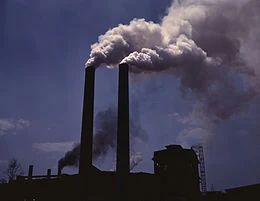AIR POLLUTION
Air pollution is defined because the excessive concentration of foreign matter within the air
which adversely affects the well-being of individual or causes damage to the property. It also affect plants, animals and other things
Watch videoControl of air pollution
Sources of air pollution:-
Natural sources
Man-made sources
Natural sources of air pollution:-
Products from atmospheric reactions
(chemical reactions like oxidation,
combination, polymerization,
photochemical reactions etc.)
Watch video Green concrete
2. Aerosols-Particulates: Aerosols are
finely divided solid or liquid particles of
micro scopic size held suspended and
dispersed in atmosphere. They cause
visibility reduction, soiling of surfaces,
corrosion etc.
The various types of aerosols are
(a) dust, (b) smoke, (c) mists, (d) fog,
(e) haze, (f) fumes.
3. Micro-organisms: Infect plants and
animals.
4. Pollens: Pollens are the small grains
from the anthers of flowers which may
cause allergic reaction.
5. Radioactive minerals:
Eg. Uranium
6. Volcanic ash and gases
7. Gases and odour from marshy lands.
MAN-MADE SOURCES OF AIR POLLUTION
Results due to human being
1) combustion of fuels in automobiles
Eg. CO2,SO2, etc
Watch video Installation of tiles
2) industries emit undesirable gases
Eg. (SO2 ,CO2 ,NO2 ,NH3 ,CO)
3) Thermal Power Plants: Mainly they
emit Sulphur dioxide.
4) Automobiles: Exhaust contains carbon
monoxide (CO), methane, un-burnt
carbon. CO is the main source of air
pollution in congested cities.
v) Agricultural activities: Crop spraying
and field burning.
vi) Nuclear Power Plants: Emit various
radioactive substances.
Also read Solid waste management
Types of air pollutants:-
Substance responsible for air pollution is known as air pollutants,they are of two types
i) Primary air pollutants, and
ii) Secondary air pollutants.
Primary air pollutants are those which
are results of natural phenomenon
E.g.: Particulate matter such as dust and
aerosols,
Pollens
Sulphur compounds (SO2,SO3,H2S )
Nitrogen compounds (NO2,NO ,NH3)
Carbon monoxide (CO) and carbon
dioxide (CO2)
Photochemical oxidants
lead
Hydrocarbons
Radioactive materials
Halogen compounds
Read Types of bacteria
Secondary air pollutants
Those pollutants which are formed in the atmosphere by reactions between two or more primary air pollutants.
Eg.
1. Sulphuric acid(H2SO4)
Sulphuric acid (H2SO4) is formed by
simple chemical reaction between sulphur
dioxide (SO2) and water (H2O) vapour. It causes acid rains.
2. Ozone(O3)
3. Formaldehyde
4. Peroxy-acetyl-nitrate(PAN)
5. Photochemical smog
2,3,4&5 etc., are formed by photochemical
reactions caused by sunlight between two
primary pollutants.
Features of air pollutants
Sulphur dioxide (SO2):
Carbon Monoxide (CO):
The automobile exhausts are the main contributors CO.The (CO) causes asphyxia i.e., loss of consciousness as a result of too little oxygen and too much carbon dioxide in the human blood.
Hydrocarbons and Photochemical oxidations:
Hydrocarbons are generally released in the atmosphere by car exhausts.
Hydrocarbons and Photochemical oxidations:
Hydrocarbons are generally released in the atmosphere by car exhausts.
Lead:-
It is mainly injected into the atmosphere from the car exhausts particularly by the automobiles running on petrol.They cause irritation of mucous membranes of nose, throat and lungs.
Oxides if nitrogen:
It is most largest pollutants of air in large cities after SO2The oxides of nitrogen are produced from air oxidation,











0 Comments